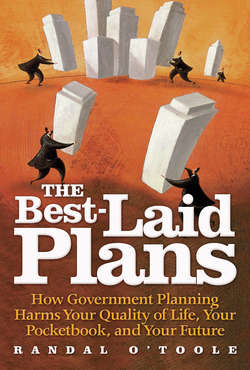Читать книгу The Best-Laid Plans - Randal O'Toole - Страница 16
5. The Return of Fire Dominance
ОглавлениеAs the decline of national forest timber sales reduced the controversy over clearcutting, a controversy over fire management has taken its place. Like timber, the fire issue also has its roots in budgetary incentives. In 1908, Congress passed a law that effectively gave the Forest Service a blank check for “emergency fire suppression.” In 1924, Congress passed the Weeks Act, which provided the Forest Service with funds to distribute to the states to encourage the formation of state and local fire protection districts. Together these laws “helped to bring political power to the Forest Service,” says fire historian Stephen Pyne.1 Yet “as that power grew, the Service found itself subtly corrupted in spirit and imagination.”2
Initially, that corruption was expressed in the Forest Service’s attitude toward prescribed burning. Private landowners and university researchers found that, in many parts of the West and South, frequent light fires favored commercially valuable trees and prevented the buildup of fuels that could lead to catastrophic fires. But for several decades, the Forest Service ignored this research and sometimes suppressed publications by its own researchers who came up with similar results.3
For many years after passage of the Weeks Act, the Forest Service also refused to distribute federal fire protection funds to states that allowed prescribed burning. Many private landowners, particularly in the South, refused to join forest protection districts until the Forest Service completely reversed this policy in the 1950s. Until landowners joined those districts, Forest Service officials spitefully recorded all prescribed fires on their lands as “wildfires.”
The 1970s were the wettest decade of the 20th century, and as a result, the United States experienced the fewest number of acres of wildland fires. Despite this, the costs of the blank-check emergency fire suppression program rose rapidly, raising alarm bells in the Office of Management and Budget. In 1978, Congress repealed the blank-check law and instead gave the Forest Service a fixed amount of money for fire suppression each year. When fire costs exceeded this amount, the Forest Service was expected to borrow the money from its Knutson-Vandenberg (K-V) fund and then repay it in future years when costs were less than the annual appropriation.
The Forest Service responded with many cost-cutting measures, including allowing forests to let natural fires burn instead of suppressing every fire and changing strategies from suppressing fires on every acre to containing fires within natural boundaries. Average annual fire costs fell dramatically for several years. However, droughts in 1987 and 1988 forced the Forest Service to severely deplete the K-V fund. So in 1990, Congress gave the Forest Service a supplementary appropriation of nearly $280 million to replenish the fund.4
Congress’s action effectively restored the blank-check mentality and reduced the incentive for forest managers to control costs. An internal Forest Service review in 2003 found that fire managers continued to act as though “suppression funds [were] unlimited.” They spent millions of dollars on little-used rental cars, unnecessarily purchased upscale camping gear for crews, and paid exorbitant rates for firefighting equipment.5
Such free spending offers many opportunities for corruption. In 2006, a Forest Service purchasing agent in Oregon was discovered to have paid her boyfriend more than $640,000 in firefighting funds. No one in the agency missed the funds; she was caught only after someone tipped off the local district attorney that the couple was gambling away unusually large amounts of money.6
In 2000, a prescribed fire lit on the Bandolier National Monument escaped control and swept across the Santa Fe National Forest into Los Alamos, where it burned hundreds of homes. Congress responded by increasing the Forest Service’s budget by a whopping 38 percent and asking the Forest Service and other federal land agencies to write a national fire plan.
The Forest Service long ago agreed with private landowners that some forests benefit from frequent light fires. But not all do: while 85 percent of the mostly private forests in the South need frequent fires, only about a third of forests in the West, where most federal lands are located, fall into this category. Without making any effort to determine where the money would be most effectively spent, the National Fire Plan simply asked for huge appropriations for treating forests to reduce fire hazards.
Congress accommodated the agency by passing the Healthy Forests Restoration Act of 2003, which allowed the Forest Service to spend timber sale revenues on activities aimed at reducing fire hazards. This effectively laid the perverse incentives created by the Knutson-Vandenberg Act on top of the perverse incentives created by the blank check. Predictably, in 2006 the U.S. Department of Agriculture inspector general’s office charged that the Forest Service had failed to “ensure that the highest priority fuels reduction projects [were] being implemented.”7
In the meantime, the Forest Service is rewriting the plans for each national forest. Because no one in the Forest Service dared tell Congress that its billion-dollar planning process was a failure, Congress did not change the law requiring forests to revise their plans every 10 to 15 years. So the agency continues to spend money on a process in which no one, from the chief of the Forest Service on down, seriously believes.8 The status quo suits Congress, which finds it easier to let government agencies waste taxpayers’ money than to agree on a sensible public lands policy. It suits the Forest Service, which gets bigger budgets and a larger bureaucracy. And it suits some forest users, who vaguely hope they can use the planning process to get what they want out of the national forests. Taxpayers who must pay the cost and members of the public who are frustrated by bad forest management have no influence.
